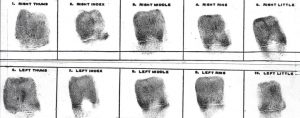Fingerprints are the unique impressions left by the raised ridges of the fingers (and palms, soles of the feet, and toes). They are caused by sweat and can be detected in a number of ways using dyes, lasers, or chemicals and have been used in identifying people for over a century. This is especially true when it comes to keeping track of our criminal element. These prints can be dusted, recorded and digitally analyzed to compare one from the other and with millions of fingerprints on record, no two have ever been the same although statistically, it is a possibility. A mathematician worked out the probability of this happening as a 1 in 64 billion chance of two fingerprints matching. With the world population at 7.6 billion people (2018, World Population Clock) and 10 fingers on each person (at least a majority of people will have 10 fingers) this would mean there is an 11 percent possibility of two fingerprints being the same, given the variables of those 64 billion. So, technically it is a possibility but the reality is that there has never been a proven case of this happening; even identical twins have different fingerprints.
Fingerprints begin to form in utero around the 12th week of gestation and are completely formed by the 7th month. It is believed that the immediate environment within the womb has a direct influence on the development of the prints although the whole development is not completely understood. There are a number of factors that combine to influence fingerprint formation including genetics, the flow of the amniotic fluid, position within the womb, and even the length of the umbilical cord. With all these contributing factors, is it any wonder that everyone has such a unique set?
 There are three basic patterns types in fingerprints; the arch, loop, and whorl, then combinations of these and the directionality of the loops and whorls. These patterns are formed in the innermost layer of the epidermis called the basal cell layer. This layer is placed between the outermost layer, the epidermis (skin) and the thick dermis layer that acts as a support to the epidermis. The basal cells are constantly producing new cells that are pushed up into the layer above because these cells, in a fetus, are produced quicker than either the dermis or epidermis. This growth causes the basal cell layer to fold creating different patterns. Since fingerprints are formed in this layer damage to the surface does not dramatically alter the print.
There are three basic patterns types in fingerprints; the arch, loop, and whorl, then combinations of these and the directionality of the loops and whorls. These patterns are formed in the innermost layer of the epidermis called the basal cell layer. This layer is placed between the outermost layer, the epidermis (skin) and the thick dermis layer that acts as a support to the epidermis. The basal cells are constantly producing new cells that are pushed up into the layer above because these cells, in a fetus, are produced quicker than either the dermis or epidermis. This growth causes the basal cell layer to fold creating different patterns. Since fingerprints are formed in this layer damage to the surface does not dramatically alter the print.
Humans are not the only animals to have fingerprints. Our closest relatives, the great apes also have them. Gorillas, chimps, and orangutans have similar fingerprints but did you know that koalas also sport them? They are said to look almost identical to a humans but they have one defining characteristic, two thumbs on each hand. If you have committed a crime down under, you could always use the koala defense. “It wasn’t me; it was the cute, cuddly guy in that gum tree!”
Why do we have fingerprints? What purpose do they serve? For a long time researchers believed that a person’s fingerprints offered a better gripping power but a study done in 2009 in Manchester, UK proved the opposite. The ridges of a fingerprint actually 33 percent less contact than a smooth surfaced finger; prints reduce our grip strength than improves it. The ridges of the fingerprint may actually improve our sense of touch. A study done at the Ecole Normale Superiure in Paris found that a fingertip moving across a surface can produce vibrations that are detected by special nerve endings called Pacinian corpuscles (see previous blog: I Think I Hear Something). These nerves pass sensory information to the brain.
Fingerprinting is one of the first examples of biometric identification but there are other forms utilizing a physical attribute that is nearly unique to humans include: iris recognition– the iris has unique patterns that are complex and stable and completely different from retinal scanning; tongue print-tongues consist of many ridges, wrinkles, seams and marks that are unique to every individual; voiceprint; and DNA profiling, also known as genetic fingerprinting. Forensic dentistry has also been used as an identifier, but bite mark analysis is notable for being unreliable. The future of biometric identification seems to be growing with every new discovery of our individual uniqueness.
Another truly interesting development in the field of forensic identification has got to be bacterial fingerprint. Human fingertip microflora is transferred when an individual touches a surface and is another characteristic unique to an individual and also can show a host of information on the host such as geographical origins. This fingerprint can be used because of its uniqueness and their ability to remain unchanged for several weeks. It may be something that can be used for identification when other avenues such as fingerprinting and/or DNA are unavailable. If you are planning to commit a crime, you may want to consider all the new ways you can be identified and caught before you do it.
–Janice Willson
References:
https://www.ncbi.nlm.nih.gov/pmc/articles/PMC2955242/
Photo Source: the author, handprint; Daly City, CA Medical Examiner, fingerprint set

